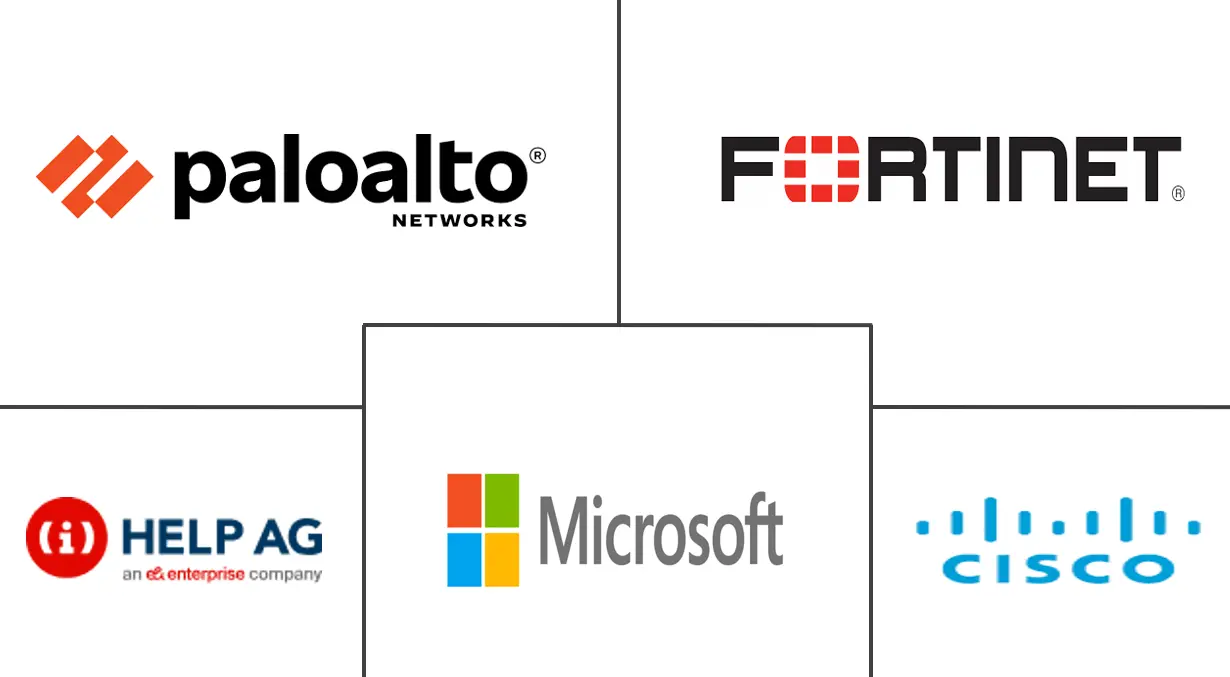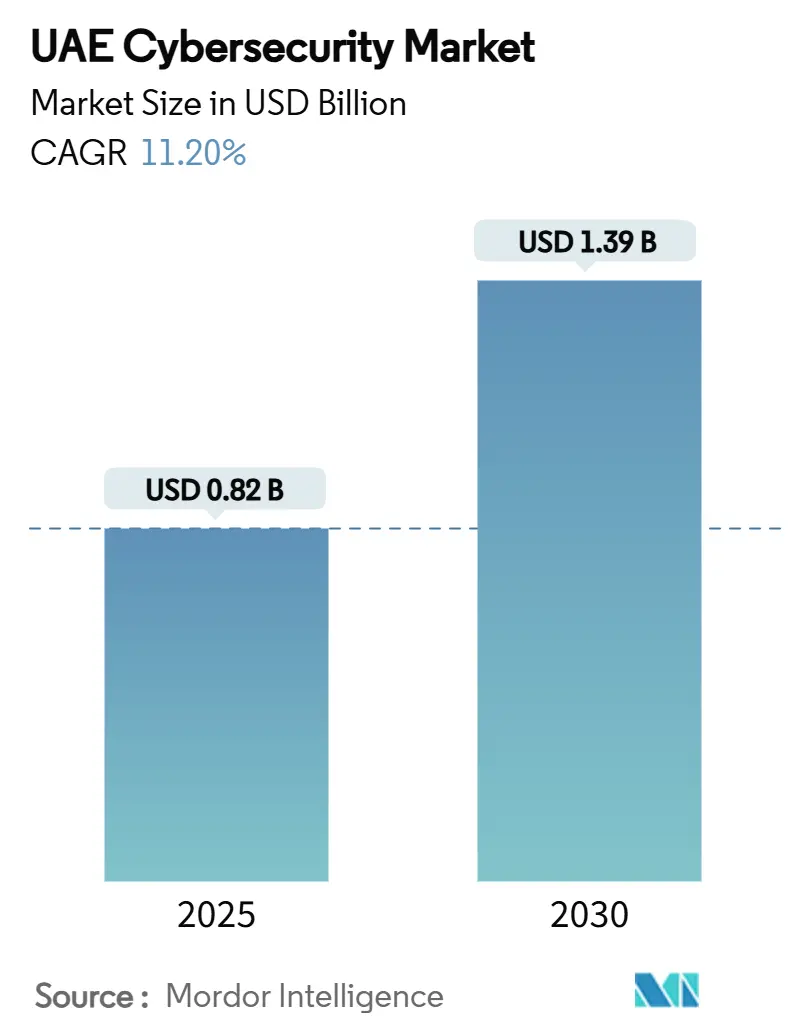
UAE Cybersecurity Market Analysis by Mordor Intelligence
The UAE cybersecurity market size is estimated at USD 0.82 billion in 2025 and is projected to advance to USD 1.39 billion by 2030, corresponding to an 11.20% CAGR during the forecast period. This steady expansion underscores the federation’s decision to embed security spending inside every flagship digital programme, from sovereign-cloud migration to critical-infrastructure automation. Heightened government oversight, proven by the National Cybersecurity Strategy’s rolling compliance audits, has transformed what was once ad-hoc procurement into predictable, multi-year budget allocations. Demand is further amplified by simultaneous roll-outs of smart-city utilities, AI-enabled public services and industry-specific digital twins, all of which enlarge the attack surface and oblige adoption of zero-trust architectures and real-time threat analytics. Vendor competition has intensified in response, producing shorter innovation cycles, localised Arabic-language threat-intelligence feeds and turnkey managed-service offerings aimed at closing persistent skills gaps. In parallel, the private sector’s pivot toward outcome-based contracts—where risk-reduction metrics outweigh hardware counts—signals a maturing purchasing culture that should stabilise average selling prices even as volumes rise.
Key Report Takeaways
- By offering, solutions captured 70.90% of UAE cybersecurity market share in 2024, while services are forecast to expand at a 14.8% CAGR through 2030.
- By deployment mode, on-premise implementations led with 58.20% share of the UAE cybersecurity market size in 2024, whereas cloud deployments are on track for a 15.10% CAGR between 2025 and 2030.
- By end-user industry, the BFSI segment dominated with a 24.20% revenue share in 2024; healthcare is positioned to grow fastest at 16.60% CAGR to 2030.
- By end-user enterprise size, large enterprises held 64.50% of the UAE cybersecurity market share in 2024, while SMEs are projected to register a 14.20% CAGR during the forecast horizon.
UAE Cybersecurity Market Trends and Insights
Drivers Impact Analysis
| Driver | (~) % Impact on CAGR Forecast | Geographic Relevance | Impact Timeline |
|---|---|---|---|
| Mandatory IAS and National Cybersecurity Strategy enforcement | +3.2 | Abu Dhabi, Dubai | Short term (≤ 2 years) |
| Smart-city and federal digital projects widen attack surface | +2.8 | Dubai, Abu Dhabi | Medium term (2–4 years) |
| OT-Security Spend Surge in Oil and Gas (ADNOC, ENOC) | +1.9 | Abu Dhabi, Sharjah, Dubai | Medium term (2–4 years) |
| Sovereign Public-Cloud Roll-outs Stimulating Cloud-Native Security Uptake | +2.5 | National, led by Abu Dhabi | Medium term (2–4 years) |
| Rise of digital-only banking and FinTech licences | +1.7 | Dubai (DIFC), Abu Dhabi (ADGM) | Short term (≤ 2 years) |
| UAE Federal Data-Protection Law (45/2021) Fueling DLP and Privacy Tools | +2.3 | National | Short term (≤ 2 years) |
| Source: Mordor Intelligence | |||
Mandatory IAS and National Cybersecurity Strategy Enforcement
Federal Information Assurance Standards mandate risk assessments, layered controls and incident-response testing across critical infrastructure. Continuous audits by the National Electronic Security Authority have normalised compliance spending, leading organisations to lock-in multi-year contracts covering governance tooling, security analytics and workforce certification programmes. Vendors that automate evidence collection and policy mapping observe shorter sales cycles, as buyers seek to streamline reporting obligations. This regulatory rigidity also lowers payment-default risk, making the UAE cybersecurity market attractive to global suppliers establishing regional delivery centres [1]National Electronic Security Authority, “UAE Information Assurance Standards,” nesa.gov.ae .
Smart-City and Federal Digital Projects Widen Attack Surface
Dubai’s Smart City framework and Abu Dhabi’s 200-plus AI government services weld IoT sensors, 5G backbones and data lakes into platforms that require continuous monitoring. For example, DEWA’s AED 7 billion smart-grid ties electricity and water networks to real-time automation, creating new OT entry points that adversaries can exploit. Consequently, demand spikes for micro-segmentation, AI-driven network analytics and encrypted machine-to-machine communications. Integrators report that initial budgets often rise by 12–15% once security scoping is finalised, revealing a hidden uplift that propels overall UAE cybersecurity market growth [2]Dubai Electricity and Water Authority, “Smart Grid Programme,” dewa.gov.ae.
OT-Security Spend Surge in Oil and Gas (ADNOC, ENOC)
ADNOC’s USD 920 million well-digitalisation contract installs private-5G networks and AI optimisation tools across more than 2,000 wells, obliging deployment of industrial firewall gateways, anomaly-detection engines and secure-coding standards for programmable-logic controllers. Given hydrocarbon revenues’ strategic importance, threat-modelling exercises now drive procurement decisions at board level, reinforcing a security-first culture that permeates subcontractor selection. Integrators possessing both telecom and SCADA expertise enjoy double-digit order-book growth, underscoring convergence between connectivity and cyber-protection.
Sovereign Public-Cloud Roll-outs Stimulating Cloud-Native Security Uptake
Abu Dhabi’s AED 13 billion Digital Strategy mandates 100% sovereign-cloud adoption for government services by 2027. The Khazna–G42 merger now operates the largest domestic data-centre footprint, pairing compute capacity with built-in security controls vetted by regulators. Public agencies and heavily regulated industries turn to cloud-access security brokers, confidential-computing chipsets and policy-orchestration layers that harmonise local residency obligations with global compliance frameworks. Suppliers pre-certified for Khazna regions close deals up to 30% faster than non-certified competitors, a premium that heightens the UAE cybersecurity market’s cloud-security sub-segment attraction.
Restraints Impact Analysis
| Restraint | (~) % Impact on CAGR Forecast | Geographic Relevance | Impact Timeline |
|---|---|---|---|
| Emirati cyber-talent shortage inflates costs | −2.1 | National, acute in Dubai | Medium term (2–4 years) |
| Multi-cloud integration and vendor lock-in concerns | −1.4 | National, large enterprises | Short term (≤ 2 years) |
| Budget re-allocation to GenAI projects | −1.6 | Dubai, Abu Dhabi | Short term (≤ 2 years) |
| Export-control hardware bottlenecks | −0.8 | National | Short term (≤ 2 years) |
| Source: Mordor Intelligence | |||
Emirati Cyber-Talent Shortage Inflating Costs
Fortinet’s 2024 skills-gap survey shows 58% of UAE organisations struggle to fill security roles, driving monthly salaries for senior analysts above AED 67,000. Cost inflation leads enterprises to outsource monitoring or deploy AI-assisted response to stretch limited headcount. While initiatives such as Dubai’s Cyber Node aim to train new talent, output lags demand, elongating project timelines and creating temporary reliance on expatriate contractors, thereby raising longer-term operational costs.
Multi-Cloud Integration and Vendor Lock-in Concerns
Roughly 67% of UAE enterprises already run mission-critical workloads across two or more clouds, yet most rely on native security controls that do not translate across providers. Misconfigurations therefore proliferate, prompting boards to delay certain migrations until parity tools mature. Organisations demand cloud-agnostic posture-management dashboards and open-standard APIs, but such platforms remain scarce, restricting short-term uptake and shaving predicted growth by close to 1.4 percentage points.
Segment Analysis
By Offering: Services Close the Gap on Solutions
Solutions continue to command 70.90% UAE cybersecurity market share in 2024 as legacy endpoint, gateway and encryption tools remain indispensable for baseline defence. However, managed and professional services are projected to log a 14.8% CAGR, outpacing overall UAE cybersecurity market growth as enterprises confront talent shortages and regulatory complexity. Advisory demand soars for privacy-impact assessment, zero-trust strategy and red-team simulation, while managed detection and response contracts increasingly include outcome-based clauses tied to mean-time-to-detect benchmarks. Parallel growth in pay-as-you-grow subscription models ensures SMEs participate, reinforcing services’ upward trajectory.
Cloud-security, data-loss prevention and identity-governance software remain the most requested solutions, energised by sovereign-cloud mandates and Law 45/2021 privacy requirements. Hardware continues to sell into OT environments, yet vendors accelerate pivot toward virtualised appliances complemented by AI analytics that consume telemetry from distributed edges. The resulting hybrid stacks blur boundaries between product and service, prompting suppliers to bundle licenses with continuous-support packages for predictive revenue.
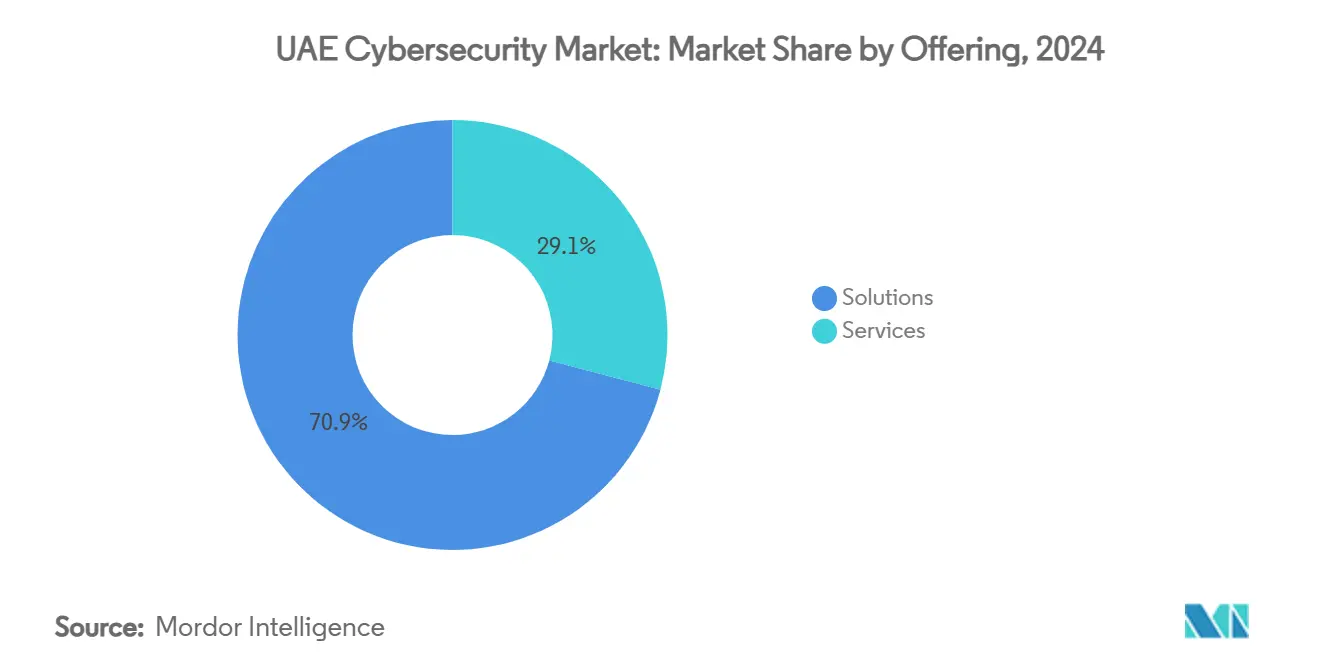
By Deployment Mode: Cloud Momentum Surges
On-premise deployments held 58.20% of UAE cybersecurity market size in 2024 due to entrenched infrastructure in energy, defense and certain financial cores. Yet cloud-based controls are forecast to advance at a 15.10% CAGR, reflecting federal edicts that new public-sector workloads must reside on sovereign clouds. Enterprises increasingly adopt cloud-access security brokers, workload-protection platforms and SaaS email-gateways to align with zero-trust frameworks. Data-residency concerns have not impeded migration because domestic data-centre expansion provides local landing zones for sensitive workloads.
Chief information security officers negotiate bandwidth, compute allotments and native key-management in their cloud contracts, proving cybersecurity is now inseparable from broader cloud economics discussions. Suppliers offering pre-built integration kits for Khazna, AWS Middle East and Microsoft Azure UAE regions shorten time-to-value, winning tender differentials.
By End-User Industry: Healthcare Tops Growth League Tables
BFSI continues to anchor revenue at 24.20% UAE cybersecurity market share owing to open-finance API mandates, digital-asset custody frameworks and stringent AML rules. However, healthcare is poised for 16.60% CAGR as telemedicine, AI diagnostics and electronic health-record roll-outs accelerate post-pandemic. Investments focus on patient-identity safeguards, medical-device segmentation and analytics that flag anomalous clinician access.
Oil and gas remains an outsized buyer, funnelling OT-specific dollars into intrusion-detection sensors, secure remote operations and AI-assisted drilling automation. Telecoms leverage 5G to offer in-line managed-security services, while retail modernises fraud-prevention stacks to secure e-commerce surges. Education, transport and media sectors follow, adopting lowest-friction SaaS controls that bundle compliance dashboards to satisfy sector-agnostic Law 45/2021 requirements.
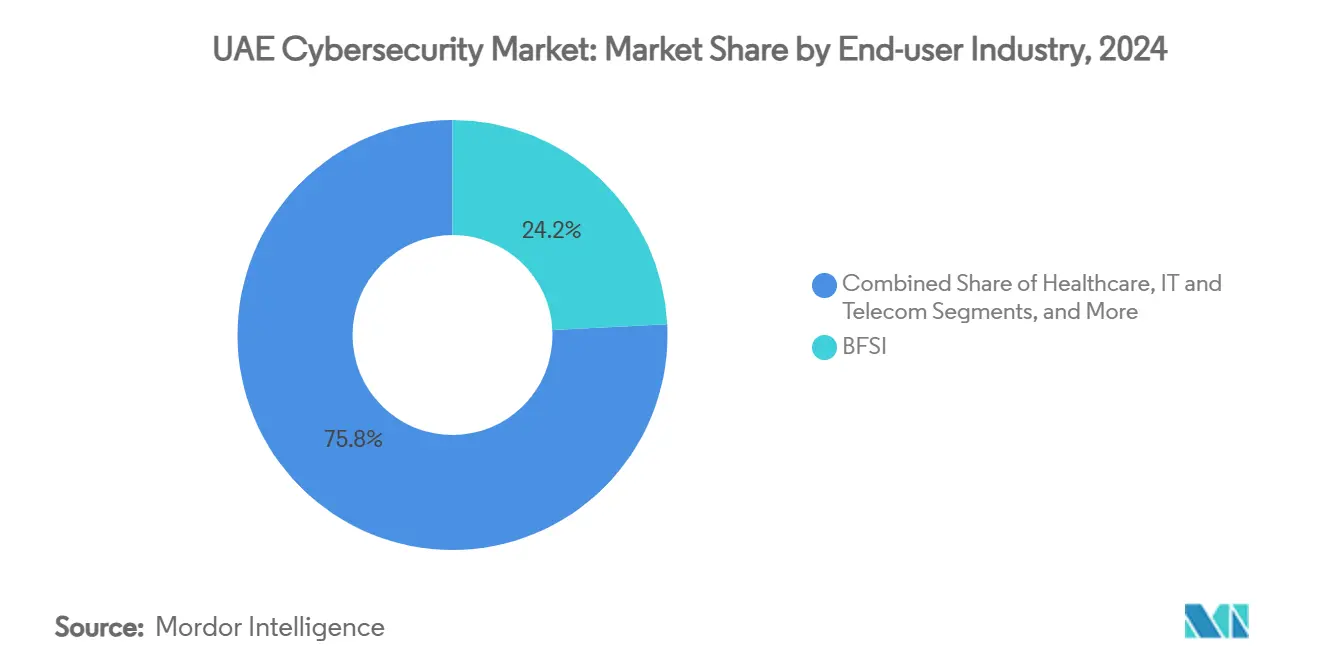
Note: Segment shares of all individual segments available upon report purchase
By End-user Enterprise Size: SMEs Accelerate Adoption
Large enterprises accounted for 64.50% of 2024 expenditure, commanding dedicated SOCs and custom zero-trust fabrics. Yet SMEs are forecast to grow at 14.20% CAGR as government grants, cyber-insurance premium incentives and affordable SaaS tiers lower entry barriers. Rising ransomware incidents targeting mid-market firms galvanise board attention, propelling budget reallocations despite lean IT teams.
Managed-security-service providers capitalise by offering modular bundles—endpoint protection, cloud posture management and 24/7 monitoring—priced per user. AI-driven automation offsets staffing constraints, making advanced detection accessible to firms previously reliant on basic anti-virus. Community banks and logistics SMEs cite regulator audits and supply-chain-customer requirements as catalysts for firm-wide security upgrades, amplifying segment momentum.
Geography Analysis
Abu Dhabi remains the single largest provincial contributor to UAE cybersecurity market size, propelled by sovereign-cloud frameworks, national-oil-company OT overhauls and AI-centric government targets. The emirate’s procurement offices frequently act as first adopters of novel regulations, enabling suppliers active here to anticipate nationwide compliance mandates and refine solutions earlier than rivals. Contracts tied to Abu Dhabi’s Digital Authority often carry multiyear extension options, improving vendor revenue visibility and lowering customer acquisition costs.
Dubai follows closely, fuelled by an ambitious Smart Dubai roadmap, bustling DIFC fintech ecosystem and tourism-rich digital platforms that transact high payment volumes. Service providers specialising in real-time fraud analytics, secure payment gateways and AI-based identity verification record strong order pipelines. Additionally, the emirate’s free-zone regulations permit accelerated proof-of-concept cycles, making Dubai an innovation hotspot where vendors pilot emerging products before rolling them across the wider GCC region.
The northern emirates—Sharjah, Ras Al Khaimah, Fujairah, Ajman and Umm Al Quwain—account for a smaller but rapidly enlarging slice of the UAE cybersecurity market. Industrial peace ports, new logistics corridors and university research parks underpin rising OT-security and academic-sector compliance needs. Regional universities collaborating on cyber-curricula feed local talent pipelines, gradually easing workforce shortages. Multi-emirate managed-service providers deploy hub-and-spoke SOC models, with centralised monitoring in Dubai or Abu Dhabi and on-site response teams stationed in industrial zones, streamlining cost-to-serve ratios.
Competitive Landscape
Global technology leaders—Microsoft, IBM, Cisco, Palo Alto Networks and Dell Technologies—dominate enterprise contracts, leveraging extensive product portfolios and strategic partnerships to meet stringent Emirati compliance requirements. Microsoft’s USD 1.5 billion investment in G42 embeds Azure services inside sovereign-cloud regions, coupling hyperscale compute with regionally certified security controls [3]Microsoft, “Microsoft to Invest USD 1.5 Billion in G42,” microsoft.com. IBM’s divestiture of certain QRadar SaaS assets to Palo Alto Networks marks a consolidation aimed at unifying SIEM and XDR capabilities, which resonates with UAE buyers seeking integrated threat-lifecycle platforms.
Regional champions Help AG, Digital14 (now operating under Presight) and CPX possess nuanced understanding of Arabic-language threat vectors, local data-sovereignty mandates and government procurement protocols. CPX’s acquisition by G42 folds more than 400 cyber specialists into an AI-centric product portfolio, accelerating development of sovereign-cloud defence suites that combine machine-learning models with data-residency assurance. Help AG continues to anchor large managed-service contracts, particularly within telecom-linked SOC deployments, and leverages a customer-success framework that aligns service levels to regulator-defined key-risk indicators.
White-space opportunities remain in OT-security, cloud-agnostic posture management and SME-tailored managed services. Vendors that stitch Arabic natural-language processing into threat-intel pipelines enjoy early-stage differentiation, as do providers embedding confidential-computing chips into cloud-workload protection offerings. The competitive intensity is expected to rise as global cloud providers finalise new regional availability zones, drawing additional ecosystem partners to the UAE cybersecurity industry and redefining collaboration models around shared-responsibility security.
UAE Cybersecurity Industry Leaders
-
Cisco Systems, Inc.
-
Palo Alto Networks, Inc.
-
Fortinet, Inc.
-
Microsoft Corporatiom
-
Help AG (e& Enterprise)
- *Disclaimer: Major Players sorted in no particular order
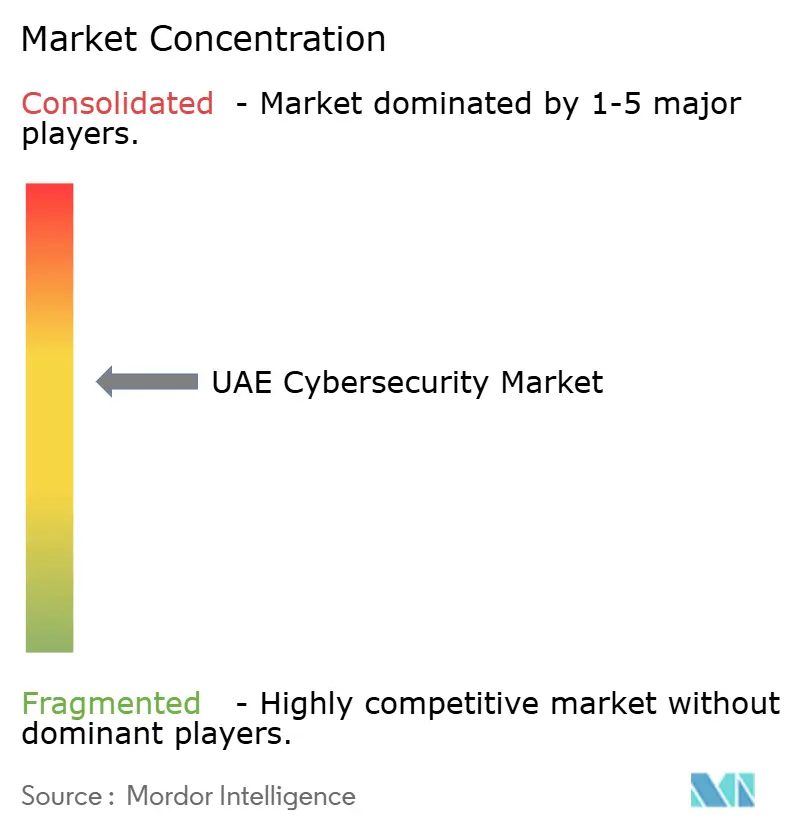
Recent Industry Developments
- May 2025: The Data Security Council of India (DSCI) hosted the second edition of the Indo-UAE Cybersecurity Exchange in Dubai, reinforcing bilateral cooperation.
- April 2025: With backing from Google, the UAE has unveiled plans for a Cyber Security Centre of Excellence. This initiative is projected to generate over 20,000 jobs and draw in an estimated USD 1.4 billion in foreign investments by 2030.
- October 2024: G42 acquired CPX, integrating 400+ specialists to strengthen end-to-end AI and security capability across sovereign-cloud deployments.
- October 2024: Core42 and AMD forged a confidential-computing partnership to secure sensitive workloads for cloud customers in the UAE.
UAE Cybersecurity Market Report Scope
Cyber threats are internet-based efforts to disrupt or damage information systems and hack crucial information using malware, spyware, and phishing. Cybersecurity solutions aid organizations in monitoring, detecting, reporting, and countering cyber threats to maintain data confidentiality.
The UAE cybersecurity market is segmented by offerings (solutions [application security, cloud security, data security, identity access management, infrastructure protection, integrated risk management, network security, end-point security, and other solution types] and services [professional services and managed services]), by deployment (On-premise, and cloud), by organization size (SMEs, large enterprises), by end-user vertical (BFSI, healthcare, IT and telecom, industrial and defense, retail, energy and utilities, manufacturing, and other end-user industries). The market sizes and forecasts are provided in terms of value in (USD) for all the above segments.
| Solutions | Application Security |
| Cloud Security | |
| Data Security | |
| Identity and Access Management | |
| Infrastructure Protection | |
| Integrated Risk Management | |
| Network Security | |
| End-point Security | |
| Services | Professional Services |
| Managed Services |
| Cloud |
| On-Premise |
| BFSI |
| Healthcare |
| IT and Telecom |
| Industrial and Defense |
| Retail and E-commerce |
| Energy and Utilities |
| Manufacturing |
| Others |
| Large Enterprises |
| Small and Medium Enterprises (SMEs) |
| By Offering | Solutions | Application Security |
| Cloud Security | ||
| Data Security | ||
| Identity and Access Management | ||
| Infrastructure Protection | ||
| Integrated Risk Management | ||
| Network Security | ||
| End-point Security | ||
| Services | Professional Services | |
| Managed Services | ||
| By Deployment Mode | Cloud | |
| On-Premise | ||
| By End-user Industry | BFSI | |
| Healthcare | ||
| IT and Telecom | ||
| Industrial and Defense | ||
| Retail and E-commerce | ||
| Energy and Utilities | ||
| Manufacturing | ||
| Others | ||
| By End-user Enterprise Size | Large Enterprises | |
| Small and Medium Enterprises (SMEs) | ||
Key Questions Answered in the Report
What will the UAE cybersecurity market size be in 2030?
It is projected to reach USD 1.39 billion by 2030, advancing from USD 0.82 billion in 2025 at an 11.20% CAGR.
Which segment contributes most revenue in the UAE cybersecurity market?
Solutions lead with 70.90% 2024 revenue share, though services are expanding faster at 14.8% CAGR.
Why is healthcare cybersecurity spending rising fastest?
Accelerated electronic health-record adoption, telemedicine growth and AI diagnostics drive heightened data-protection requirements and 16.60% forecast CAGR.
How do sovereign-cloud projects affect procurement?
They push organisations toward cloud-native controls certified for local data centres, shortening vendor shortlists to those meeting residency mandates.
Page last updated on:
